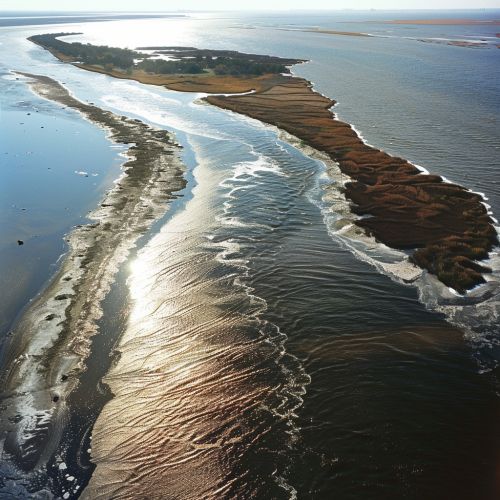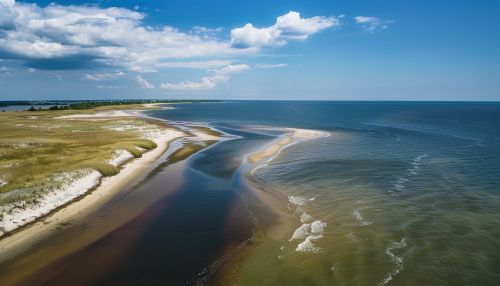Delaware Bay
Geography
Delaware Bay is a major estuary outlet of the Delaware River on the Northeast seaboard of the United States, approximately 782 square miles (2,030 km2) in area. The bay's freshwater mixes for many miles with the salt water of the Atlantic Ocean.
The bay is bordered inland by the States of New Jersey and Delaware, and the Delaware Capes, Cape Henlopen and Cape May, on the Atlantic. The bay is primarily bordered on the west by the Delaware River and is bordered on the east by the Atlantic Ocean.


Ecology
The Delaware Bay is home to more than 200 species of fish, including the Atlantic sturgeon and the American eel. It is also a critical part of the Atlantic Flyway, one of four major waterfowl migration flyways in North America. The Delaware Bay is a critical stopover for migrating shorebirds, especially the red knot, which eats the eggs of horseshoe crabs on the beaches of the bay to refuel for its long journey.
The bay's marine environment also supports a wide range of shellfisheries, including the eastern oyster, blue crab, and Atlantic horseshoe crab. The bay's waters also support a vibrant commercial fishing industry, particularly for shad and striped bass.
History
The Delaware Bay was the site of the first European settlement in Delaware, Swanendael, established by the Dutch in 1631. The bay was named for Thomas West, 3rd Baron De La Warr, an English nobleman and Virginia's first colonial governor, who made his first voyage to America in 1610.
The bay played a crucial role in the American Revolutionary War. The British Royal Navy blockaded the bay in 1776, cutting off supplies to the American rebels. The blockade was lifted in 1778, but the British continued to use the bay as a base for raids on American shipping.
In the 19th century, the bay became a major hub for oyster harvesting, which led to overharvesting and a decline in the oyster population. In the 20th century, the bay became a popular destination for recreational boating and fishing.
Economy
The Delaware Bay is a significant economic resource. The bay's waters support commercial fishing, shellfishing, and recreational boating and fishing. The bay is also a major shipping route, with the Port of Wilmington serving as a major international port.
The bay's beaches and natural beauty also support a vibrant tourism industry. The bay's waters and beaches are popular destinations for birdwatching, especially during the spring shorebird migration.
Conservation
The Delaware Bay is a critical habitat for many species, and conservation efforts have been ongoing to protect and restore these habitats. The bay is part of the National Estuarine Research Reserve System, a network of protected areas established for long-term research, water-quality monitoring, education, and coastal stewardship.
Conservation efforts in the bay have focused on restoring oyster populations, protecting migratory shorebird habitats, and improving water quality. These efforts have been led by a variety of organizations, including the Delaware Bay Estuary Project, the Delaware Division of Fish and Wildlife, and the Delaware Department of Natural Resources and Environmental Control.
